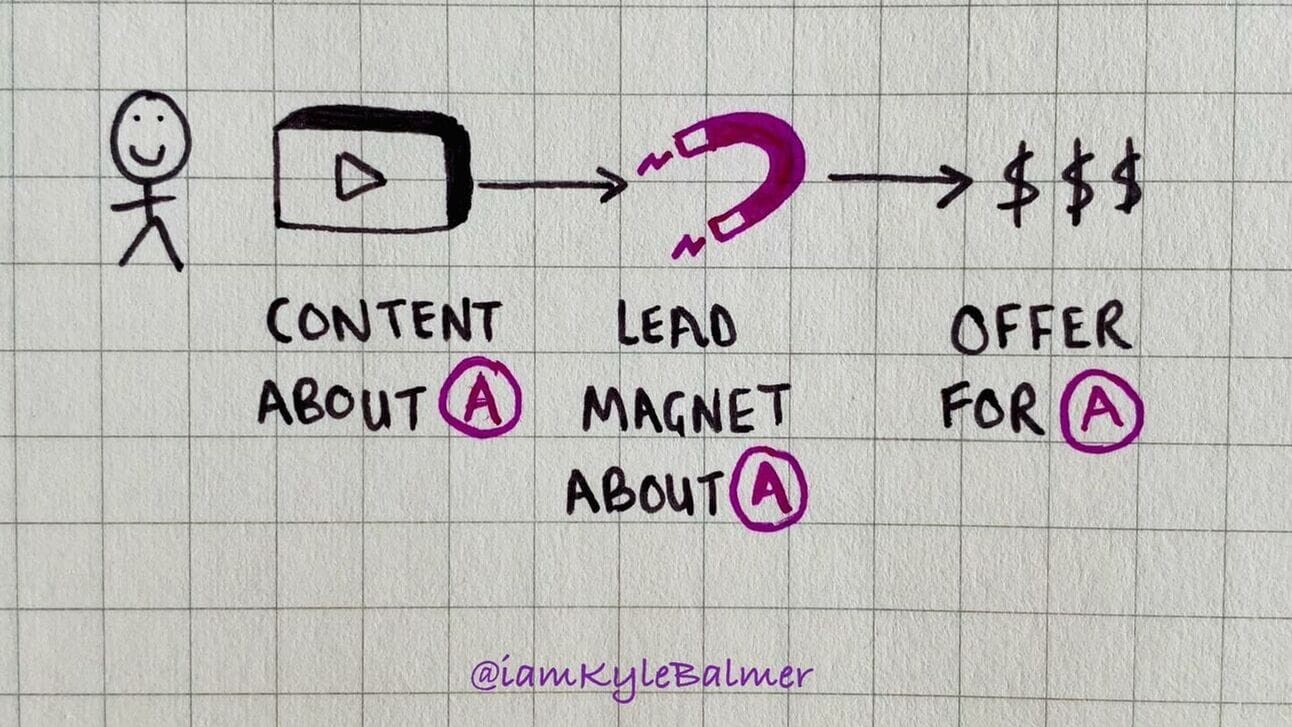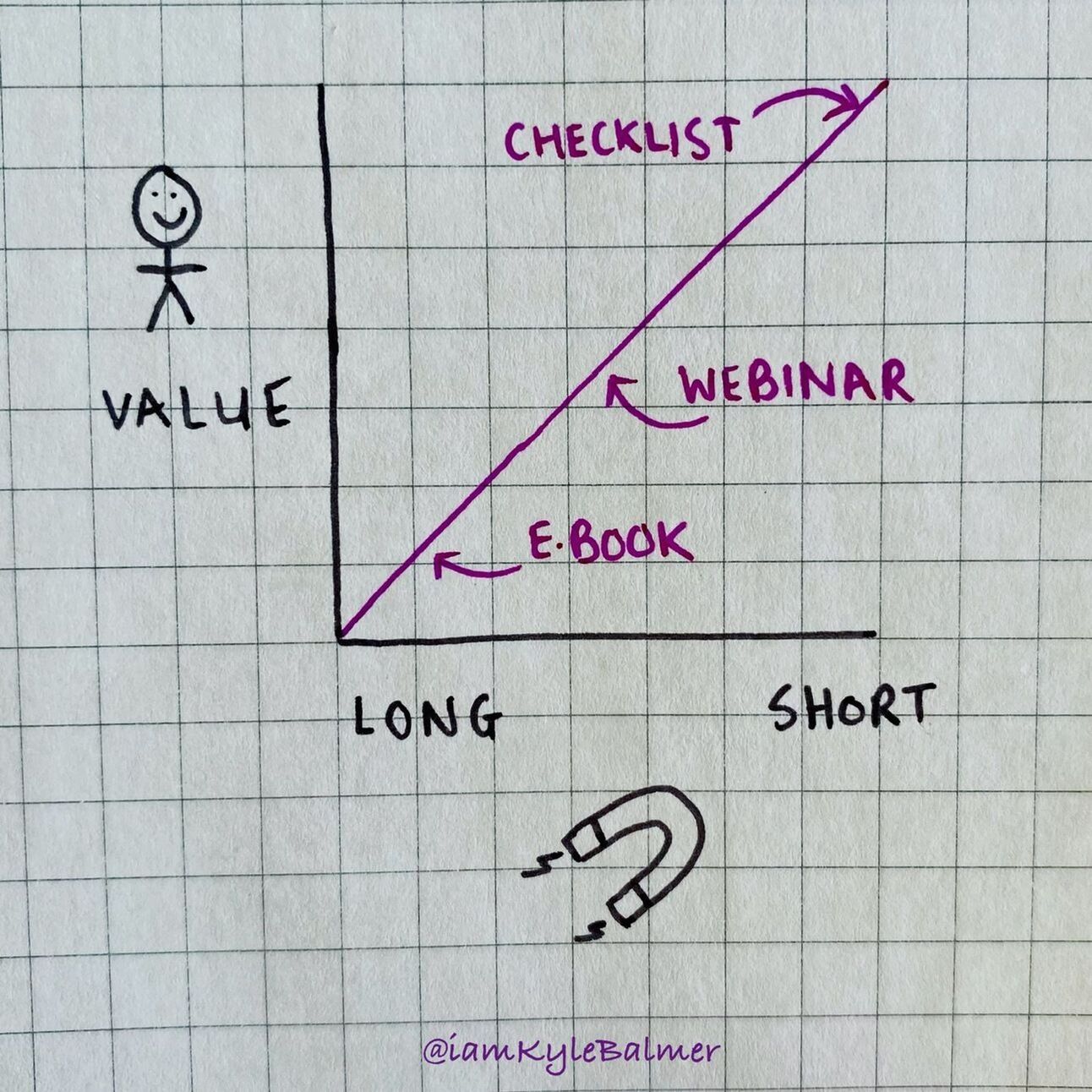Part 3 - Lead magnet to tripwire
Let’s talk about the powerful 1-2 punch of a lead magnet followed by a tripwire offer.
Successfully deployed this will reduce your customer acquisition cost to $0 which, you don’t need me to tell you, will set you up pretty well!
Let’s get started:
Lead magnet to tripwire
- what’s a lead magnet?
- use lead magnet to test customer problems
- designing a powerful lead magnet
- combining with a tripwire
The first step in our sales funnel is to bring people from our Audience into our Tribe.
We usually do this by capturing their email address. By doing so we now have permission to talk to them. It’s the first sign that they are genuinely interested in what we have to offer.
We capture this email using something called a lead magnet. It’s exactly what is sounds like - magnet to attract leads.
I’ve written a whole Playbook on lead magnets - you can find it here: Lead Magnets Prompt Playbook.
We’ll cover the basics in this Part, especially how lead magnets and tripwires relate to the wider sales funnel structure.
Keep hold of the thread
First of all this is where we carry our audience through to the beginning of our sales process.
However which way we are building an audience we need to make the next step (the lead magnet) make sense.
This is the case whether we are using:
- organic content (ie. social media, blog articles)
- paid advertising
- or any other way to get in front of people
You need the lead magnet to be congruent (wow word!) with the content.
For example I’ll use my own content and lead magnet. My content on social media talks about the usage of AI in business. How-tos, FAQs, AI news, tools etc.
My lead magnets are more in-depth guides about how to deploy AI in business. Lead magnets are generally in the format of a checklist, short video, a mini eBook, a trial of a software, a chemistry call or some other “taster” format.
There’s a consistency. I don’t do funny videos about cats and then expect people to download my AI guides. That’s not going to fly.

That consistency comes from focusing on my customer’s problems.
For example one problem my customers have is “what business should I start?”
I’ll have content about this, giving frameworks, breaking down business ideas, talking about what makes a good business or a bad business. Then I’ll present a lead magnet that addresses these topics in a lot more detail.
Importantly these are also topics I address later in my products. For example I have a mini-course called the Niche Navigator which is presented to people who have these problem.
Testing ground
Lead magnets are fantastic for genuinely working out what problems your customers actually have.
We can hypothesise for days about what we think their problems are. But ultimately we need to put offers in front of people and see what they react to.
That’s the ultimate tell. Anything else is guess work.
For this reason I recommend making lots of lead magnets.
Personally I have about 40 lead magnets. And each is pushed to different platforms, with different creatives, which means the total number of lead magnet variations is closer to 200!
This allow me to see what people actually want. No more guess work.
In my case for example I’ve had some super powerful lead magnets:
- organic lead magnet - one talking about how to run AI workshops for business led to 900+ requests for the lead magnet - that’s 900 new leads in my sales funnel
- paid lead magnet - one offering an “AI Business Blueprint” has decimated all other paid lead magnet offers I run, allowing me to acquire a lead for $0.19.
I only know this from testing. Putting out a range of offers, solving a range of customer problems. And seeing which of them resonate best.
This tells me that these are topics that audience member are really into. And thus I need to focus my sales funnel here.
Once you know this you can start to lock the best performing lead magnets in place and optimise on them.
Designing a lead magnet

Lead magnets should be:
- fast for you to produce
- fast for people to consume
- high value density
- designed to answer questions whilst opening up more
Don’t write a whole eBook as your lead magnet. That’s a mistake I see happen again and again! Don’t do it!
It takes too long for you to produce - thus reducing the volume you can test.
It takes too long for people to consume - most will download it and forget it immediately. I’m sure you’ve done the same.
eBooks are also low density of value:time required.
Instead think of formats like resource lists, checklists, templates, swipe files and other high value but fast to create/consume items.
Let’s use a prompt to give us some ideas:
Act as a marketing funnel expert
My business is in the [topic] niche
My audience members are [audience details]
Their common problems are [list common problems]
Generate 10 lead magnet ideas addressing the range of problems.
As design guidelines the lead magnets should be:
-fast for me to produce
-fast for my audience to consume
-high value density
-designed to answer questions whilst opening up more
For example resource lists, checklists, templates, swipe files and other high value but fast to create/consume items.I’d also recommend looking at what other people in your niche use as lead magnets. Spend enough time on their socials and blog and you’ll see them. Basically anything asking for your email in exchange for something is a lead magnet.
Tripwire offers
This is a more advanced technique but it works hand in hand with lead magnets.
A tripwire is an immediate sale after someone signs up for your lead magnet.
They’ve given you their email and so you know they are interested in what you have to say.
Hitting them with an immediate next step (a sale) allows the most eager to immediately buy in.
I personally have a $20 sale that occurs after every lead I capture. It’s basically the “thank you” page - once someone gets a lead magnet they are sent to a page outlining the $20 offer.
Does everyone buy this? Absolutely not. But some do - about 1-2%.
What this means is that you can make revenue whilst collecting leads. This is especially powerful if you are paying for advertising.
Personally I pay $0.19 for an email lead. 100 leads costs me $19. But if 1% of those 100 people buys my $20 tripwire guess what? I’m cost neutral.
The tripwire immediately liquidates the cost of the advertising and you’ve acquired 100 leads for free.
What should the tripwire be? It should be an intermediary between your lead magnet and your Core offer (which we’ll discuss in the next Part). Right now just think about immediate “upgrade” offers on your lead magnet.
For example if you lead magnet is a particular lead magnet for a particular task your customers do then your tripwire could be a package of multiple checklists they’d also find useful.
We’ll get a better idea of intermediary offers once we’ve locked in our core product - which we’ll do in the next part.